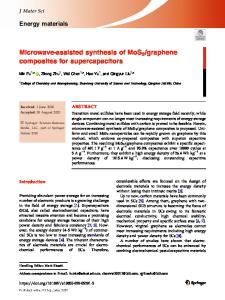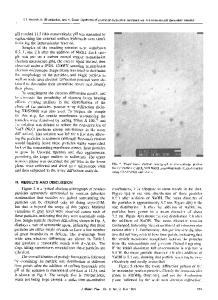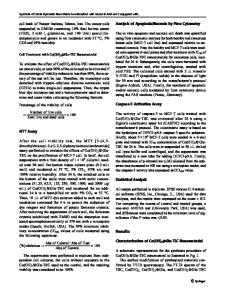Phase-controlled synthesis of Co-Mg hydroxide for high-performance hybrid supercapacitors
- PDF / 2,996,973 Bytes
- 10 Pages / 595.276 x 790.866 pts Page_size
- 78 Downloads / 308 Views
ORIGINAL PAPER
Phase-controlled synthesis of Co-Mg hydroxide for high-performance hybrid supercapacitors Jia Wang 1 & Jiayi Rui 1 & Jingzhou Yin 1,2 & Guolang Zhou 1 & Lili Zhu 1 & Hao Wang 1 & Pusu Zhao 1 & Lili Zhang 1 Received: 12 August 2020 / Revised: 21 September 2020 / Accepted: 7 October 2020 # Springer-Verlag GmbH Germany, part of Springer Nature 2020
Abstract Two-dimensional Mg-substituted cobalt hydroxides (CoxMgy(OH)z) with different crystal phases were synthesized via a facile reaction of magnesium (Mg) powder and cobalt aqueous solution. The phases of CoxMgy(OH)z (amorphous phase and β phase) were controlled by adjusting the cobalt salt precursors. The obtained hybrid amorphous CoxMgy(OH)z (a-CoxMgy(OH)z) showed excellent specific capacitance (662.2 F g−1, 1 A g−1) than β phase CoxMgy(OH)z (β-CoxMgy(OH)z) and pure Co(OH)2 (pCo(OH)2). Additionally, the hybrid supercapacitor assembled with a-CoxMgy(OH)z and the activated carbon showed high specific capacitance (77.8 F g−1, 1 A g−1) and ultrahigh cycling stability with 99.7% retention of the first capacitance at 10 A g−1 after 5000 cycles. Keywords Co-Mg hydroxides . Amorphous phase and β phase . Supercapacitor . Material preparations
Introduction The fast growth of portable electronic instruments has greatly stimulated the research of new energy storage and conversion devices [1–3]. Supercapacitor is a kind of excellent energy storing apparatus with the merit of high power density, fast discharge and charge, excellent invertibility, and ultralong cycle life [4, 5]. The electrode materials are crucial to the supercapacitors with high specific capacitance [6]. A variety of materials, including carbon [7, 8], metal oxides [9, 10], metal hydroxides [11], conductive polymer [12], and other Electronic supplementary material The online version of this article (https://doi.org/10.1007/s11581-020-03805-0) contains supplementary material, which is available to authorized users. * Jingzhou Yin [email protected] * Guolang Zhou [email protected] * Lili Zhang [email protected] 1
Jiangsu Key Laboratory for the Chemistry of Low-Dimensional Materials, School of Chemistry and Chemical Engineering, Huaiyin Normal University, Huai’an 223001, People’s Republic of China
2
State Key Laboratory of Coordination Chemistry, School of Chemistry and Chemical Engineering, Nanjing University, Nanjing 210093, People’s Republic of China
transition metal compounds [13–15], have been synthesized to enhance the performance of supercapacitors. Among them, Co(OH)2 is an ideal electrode with high theoretical capacitance (about 3000 F g−1) [16]. However, the currently reported synthesized Co(OH)2 has a specific capacitance of less than 1000 F g−1 [17, 18]. In recent years, many kinds of CoNiLDHs have been synthesized and achieved ultrahigh specific capacitance (about 2000 F g−1) in 3-electeode system [19, 20]. However, in the actual assembled hybrid supercapacitors, the performance of CoNi-LDH is not desirable, and the higher cost also limits the further application of CoNi-LDH [6,
Data Loading...











